Ctrl + F is the shortcut in your browser or operating system that allows you to find words or questions quickly.
Ctrl + Tab to move to the next tab to the right and Ctrl + Shift + Tab to move to the next tab to the left.
On a phone or tablet, tap the menu icon in the upper-right corner of the window; Select "Find in Page" to search a question.
Share UsSharing is Caring
It's the biggest motivation to help us to make the site better by sharing this to your friends or classmates.
Bacteria
Bacteria, which are microscopic organisms that play diverse roles, from aiding digestion to causing infections, are essential for Earth's ecosystems.
microorganisms
prokaryotes
pathogens
antibiotics
infections
reproduction
evolution
respiration
diversity
growth
metabolism
plasmids
resistance
mutation
biofilm
the bacterial DNA and ribosomes enclosed in a tough case that can survive unfavorable conditions
- host cell
- microbiota
- endospore
- plasmid
What do viruses need to reproduce?
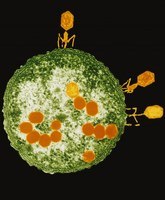
- they need genetic material
- They need a host cell
- They need bacteria
- They need insulin
62. Which bacterial structure is responsible for protecting the cell from its external environment?
- a) Cell membrane
- b) Nucleoid
- c) Ribosome
- d) Flagellum
what are the internal structures of bacteria?
- nucleoid, dna, and ribosomes
Which scientist created tests that helped confirm that bacteria and other microorganisms cause a variety of diseases?
- Robert Koch
76. Which bacterial genus includes species responsible for causing botulism?
- a) Streptococcus
- b) Clostridium
- c) Escherichia coli
- d) Salmonella
22. Which of the following bacterial diseases has been largely eradicated through vaccination programs?
- a) Polio
- b) Tuberculosis
- c) Cholera
- d) Malaria
a vaccine gives your body _______.
- the antibiotics needed to fight a virus
- a weakened or dead form of the virus
- a latent form of the virus
- peptidoglycan to resist a virus attack
harmful or helpful: bacteria help make foods
- helpful
- harmful
Viruses and some bacteria can be classified as pathogens because they
- provide oxygen
- cause disease
- recycle nutrients
- can be used to produce medicine
Which ones are GAMMA HEMOLYTIC
- S. pyogenes
- S. agalactiae
- S. dysgalactiae
- S. equi
- S. equisimilis
- S. zooepidermicus
- S. bovis (Missed)
- S. equinus (Missed)
- E. faecalis (Missed)
- E. avium (Missed)
- E. durans (Missed)
- E. faecium (Missed)
- S. pneumoniae
- S. anginosus (Missed)
- S. mutans (Missed)
- S. mitis (Missed)
- S. salivarius (Missed)
- S. sanguis (Missed)
bacteria have no what?
- nucleus
35. What is the primary function of the bacterial cytoplasm?
- a) Contains enzymes and cellular structures
- b) Stores genetic material
- c) Synthesizes ATP
- d) Facilitates cell movement
37. What is the term for bacteria that obtain energy from inorganic substances?
- a) Chemotrophs
- b) Phototrophs
- c) Heterotrophs
- d) Autotrophs
harmful or helpful: bacteria keep less friendly cells from growing in or on your body
- helpful
- harmful
63. What is the primary function of bacterial plasmids?
- a) Energy production
- b) Protein synthesis
- c) Genetic exchange
- d) DNA replication
Image: https://media.quizizz.com/_mdserver/main/media/resource/gs/quizizz-media/quizzes/5a9148af-e6ca-49fa-96ba-c6218945c6fa-v2?w=90&h=90

- Question text
6. What is the role of pili in bacteria?
- a) Sensing the environment
- b) Attachment to surfaces
- c) Photosynthesis
- d) Respiration
What is the cell part labeled as "C"

- Ribosome
Bacteria are....(select all that apply)
- Single-celled organisms
- Single-celled organisms
- Multi-cellular organisms
- Eukaryotes
- Prokaryotes
Test/s that requires 37 degrees Celsius incubation and requires CO2
- Oxidation/Fermentation (Hugh-Leifson) test
- Bacitracin susceptibility test
- Novobiocin susceptibility test
- Polymyxin B susceptibility test
- Optochin susceptibility test (Missed)
- Mannitol Salt Agar (Staphylococci identification)
- CAMP Test (Missed)
- 20% Dextrose Strip Test
- Salt Tolerance Test (Your Answer)
- Bile solubility test (Missed)
19. Which bacterial structure is responsible for attaching to host cells during infection?
- a) Adhesins
- b) Ribosomes
- c) Plasmids
- d) Nucleoids
Where do bacteria store sugars and lipids?
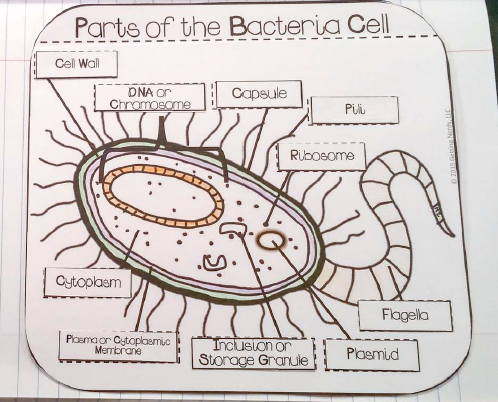
- storage granule
binary fission
- the process of cell division in prokaryotic organisms by which the parent cell divided into two genetically identical cellsby asexual reproductionvery rapid reproductionSTeps; dna molecule is copieddna molecules attach to cell membranecell membrane elongates and pinches off leaving two identical cells
89. What is the primary function of bacterial endospores?
- a) Energy production
- b) Survival in harsh conditions
- c) Protein synthesis
- d) DNA replication
Are prokaryotes more or less simple than eukaryotes?
- more
Bacteria can be both helpful and harmful.
- True
- False
57. What is the primary function of bacterial ribosomes?
- a) Storage of genetic material
- b) Protein synthesis
- c) Energy production
- d) Cell division
In batch culture, the product is collected during the two stages:
- log and decline
- log and lag
- lag and decline
- lag and stationary
The segment of DNA injected into host cells by a virus is called the
- prophage
- capsid
- plasmid
- prion
Algae is the largest producer of ___________________ on Earth.
- pond scum
- bacteria
- oxygen
- carbon dioxide
93. What is the primary function of bacterial capsules?
- a) Protection from immune cells
- b) Energy production
- c) Nutrient absorption
- d) DNA replication
Image: https://media.quizizz.com/_mdserver/main/media/resource/gs/quizizz-media/quizzes/9ee94e9e-34b9-43d7-b93e-cecda6a17fd9-v2?w=90&h=90

- Image: https://media.quizizz.com/_mdserver/main/media/resource/gs/quizizz-media/quizzes/9ee94e9e-34b9-43d7-b93e-cecda6a17fd9-v2?w=90&h=90
- Select one:
- Question text
Which ones are ALPHA HEMOLYTIC
- S. pyogenes
- S. agalactiae
- S. dysgalactiae
- S. equi
- S. equisimilis
- S. zooepidermicus
- S. bovis (Missed)
- S. equinus (Missed)
- E. faecalis (Missed)
- E. avium (Missed)
- E. durans (Missed)
- E. faecium (Missed)
- S. pneumoniae (Missed)
- S. anginosus (Missed)
- S. mutans (Missed)
- S. mitis (Missed)
- S. salivarius (Missed)
- S. sanguis (Missed)
98. Which of the following bacterial diseases is transmitted through contaminated water and causes severe diarrhea?
- a) Tetanus
- b) Anthrax
- c) Cholera
- d) Plague
23. What is the term for the protective outer layer of some bacteria that helps them resist antibiotics?
- a) Biofilm
- b) Glycocalyx
- c) Mesosome
- d) Periplasm
Which of the following fungi are HELPFUL? Check ALL that apply.
- e coli
- yeast
- salmonella
- penicillin
How does bacteria get energy
- They dont need it
- Binary fission (Missed)
- Conjuction (Missed)
28. What is the term for bacteria that live in extreme environments, such as hydrothermal vents?
- a) Thermophiles
- b) Mesophiles
- c) Psychrophiles
- d) Halophiles
name the shape

- spirillum (spiral shaped)
- bacillus (rod-shaped)
- coccus(sphere)
In continuous flow culture,
- there is more product
- there are only two stages: lag and stationary
- it is more used by the industries
- you cannot do water treatments
What is cytoplasm?
- Jel-like fluid that fills the cells and gives it shape
- Bone-like structure that give it protection
- Small structure that makes protein
- Whip-like structure that allows for movement
The two economic disadvantages of bacteria are food spoilage and
- parisitism
- production of antibiotics
- antibiotic resistance
- human disease
96. Which bacterial genus includes species responsible for causing urinary tract infections?
- a) Escherichia
- b) Escherichia coli
- c) Streptococcus
- d) Salmonella
Which is a reason that bacteria can cause infections in other organisms?
- Fast reproduction
40. Which bacterial genus includes species responsible for causing dental cavities?
- a) Salmonella
- b) Clostridium
- c) Streptococcus
- d) Lactobacillus
Which of the bacterial structures protects the cell from drying out during times of stress?

- capsule
Identify the statements that correctly describe Archaebacteria.
- Archaebacteria were discovered in the 1970s.
- Archaebacteria were discovered in the 1970s.
- Archaebacteria live in almost all habitats on Earth.
- Archaebacteria have tRNA similar to eukaryotes.
- Archaebacteria do not have peptidoglycan in their cell walls.
Which bacteria cell part goes in the box labelled with the star?

- Flagella
- DNA
- Plasma Membrane
- Cell Wall
When a virus infects a host, it first attaches to the host cell, injects its genetic material, then
- assembles new viruses
- reads the genetic code
- releases new viruses
- destroys the host cell
what do plasmids do?
- they eat the other structures
- they can cause death to certain cells
- they have DNA strands that are separate from the main structure
- they take the DNA out of the cell
conjugation
- the process by which a plasmid is transferred from one bacterial cell to another
a virus has a, ______, a protein coat that surrounds its nucleic acid.
- capsid
- capsule
- cell membrane
- cytosol
We can live WITHOUT microorganisms.
- True
- False
- Sometimes
- During the spring and fall.
Bacterias are microscopic
- true
- false
Prokaryotes will often move by a tail-like what?
- flagellum
Which of these characteristics of living organisms are NOT present in viruses?
- made of cells
- made of cells
- evolve
- Obtain materials for energy
- reproduce
- grow & develop
54. Which of the following bacterial diseases is transmitted through contaminated water and causes severe diarrhea?
- a) Tetanus
- b) Anthrax
- c) Cholera
- d) Plague
8. What is the primary function of the bacterial capsule?
- a) Oxygen exchange
- b) Protection from immune cells
- c) Nutrient absorption
- d) Reproduction
47. What is the term for bacteria that require organic compounds for energy and carbon sources?
- a) Heterotrophs
- b) Autotrophs
- c) Phototrophs
- d) Chemotrophs
What are the two bacteria kingdoms?
- -archaebacteria- eubacteria
64. Which bacterial genus includes species responsible for causing bubonic plague?
- a) Yersinia
- b) Clostridium
- c) Escherichia coli
- d) Salmonella
2. What is the shape of a spherical bacteria cell?
- a) Spiral
- b) Cuboidal
- c) Round
- d) Rod-shaped
Multi-celled organisms are made up of ____________________ cells.
- one
- two
- multiple
- ten
Bacteria that require oxygen in order to survive are called
- Obligate anaerobes
- Obligate aerobes
- Facultative anaerobes
Which applies to Group D strep
- Bile esculin positive
- 6.5% NaCl positive
- Optochin sensitive
- Hippurate positive
Not all bacteria has a flagella
- True
- False
Pathogens cleans of oil spills
- True
- False
Viruses are similar to _____ because they need a host cell to replicate themselves.
- decomposers
- autotrophs
- heterotrophs
- parasites
66. Which of the following bacterial diseases is transmitted through contaminated food and can lead to paralysis?
- a) Tuberculosis
- b) Botulism
- c) Cholera
- d) Tetanus
Who first discovered bacteria
- Antoni van Leeuwenhoek
- Galileo Galilei
- Hooke
- Hubert Blaine Wolfeschlegelsteinhausenbergerdorff Sr.
60. Which bacterial genus includes species responsible for causing diphtheria?
- a) Streptococcus
- b) Corynebacterium
- c) Clostridium
- d) Escherichia coli
bacteria sometimes struggle to survive. some bacteria escape this with
- outerspores
- endospores
- binary fission
- archaea
Identify the long whip like structure used for movement
- pili
- flagella
- capsule
- plasmid
transformation
- a type of gene transfer in which dna is taken from the environment
68. Which bacterial genus includes species responsible for causing dental decay?
- a) Escherichia coli
- b) Clostridium
- c) Streptococcus pneumoniae
- d) Streptococcus mutans
Which viral structure is responsible for attaching the virus to the host cell?
- capsid
- tail sheath
- tail fiber
- genetic material
What process is this?
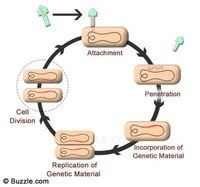
- phagocytosis
- lytic cycle
- lysogenic cycle
- formation of antibodies
42. Which of the following bacterial infections is transmitted through the bite of infected fleas?
- a) Tuberculosis
- b) Plague
- c) Cholera
- d) Tetanus
Poly-D-glutamicacid protein capsule that prevents phagocytosis.
- Bacillus Cereus
- Clostridium Botulium
- Bacillus Anthracis
- Clostridium Tetani
- Listeria monotogenes
Bacteria have short, fine, hairlike appendages called ______
- plasmids
- flagella
- spirillia
- pilli
Bacteria that are considered "extremophiles" because of the harsh environments they inhabit are in the kingdom
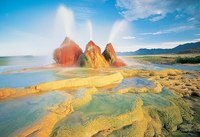
- Archaebacteria
- Eubacteria
- both kingdoms
27. Which of the following bacterial structures is involved in the exchange of genetic material during conjugation?
- a) Capsule
- b) Nucleoid
- c) Pilus
- d) Endospore
archaebacteria lives in extreme environments
- True
- False
15. Which of the following is an example of a nitrogen-fixing bacteria?
- a) Escherichia coli
- b) Rhizobium
- c) Streptococcus
- d) Staphylococcus
56. Which bacterial genus includes species responsible for causing pneumonia?
- a) Streptococcus
- b) Clostridium
- c) Streptococcus pneumoniae
- d) Escherichia coli
Protozoa serve valuable purposes. Which answers tell of this purpose. Check ALL that apply.
- Remove harmful waste from sewage at water treatment plants.
- Remove harmful waste from sewage at water treatment plants.
- Feed animals in the water.
What percentage of bacteria are harmful to humans?
- 10%
- less than 1%
- 90%
- more than 100%
What can bacteria do?
- - they can cause disease- they can help us digest our food
Test/s that requires 35 degrees Celsius incubation
- Oxidation/Fermentation (Hugh-Leifson) test
- Oxidation/Fermentation (Hugh-Leifson) test
- Bacitracin susceptibility test
- Novobiocin susceptibility test
- Polymyxin B susceptibility test
- Optochin susceptibility test
- Mannitol Salt Agar (Staphylococci identification)
- CAMP Test
- 20% Dextrose Strip Test
- Bile solubility test
- Salt Tolerance Test
- Hippurate hydrolysis test (Missed)
48. Which bacterial disease is characterized by the formation of a hard, protective case around the bacterial cell?
- a) Tuberculosis
- b) Anthrax
- c) Cholera
- d) Tetanus
coccus
- bacteria with a spherical shapeexample: staph infection
80. Which bacterial genus includes species responsible for causing urinary tract infections?
- a) Escherichia
- b) Escherichia coli
- c) Streptococcus
- d) Salmonella
What is the name of the disease-causing particle that does not contain DNA or RNA?
- Prophage
- Retrovirus
- Viroids
- Prions
97. What is the primary function of bacterial endospores?
- a) Energy production
- b) Survival in harsh conditions
- c) Protein synthesis
- d) DNA replication
Which two enterotoxins are made by bacillus cereus ?
- 1) Heat labile Toxin- that causes nausea, abdominal pain, diahera, lasts 12-24 hours
- 2) heat stable toxin - similar to S. Aureus food poisining , short incubuation, severe nausea, slight dihhera.
Which structure is used by some bacteria for movement?

- flagella
Match the scientist with his contribution to our understanding of disease:
- discovered bacteria Leeuwenhoek
- developed vaccine for Polio Salk
- developed vaccine for Small Pox Jenner
- viruses contain DNA Hershey & Chase
4. Which of the following is a method of bacterial reproduction?
- a) Binary fission
- b) Mitosis
- c) Meiosis
- d) Budding
30. What is the primary function of the bacterial cell membrane?
- a) Regulating the passage of substances in and out of the cell
- b) Synthesizing proteins
- c) Storing genetic material
- d) Providing structural support
Which of the following is not a way that bacteria are able to move?
- Lashing or snaking forward
- Gliding through slime
- Flagella
- Pili
For LC, we learn about three types of bacteria: round, ___ and spiral
- rod
Which Gram Positive- spore- making Bacillius produces neurotoxins that blocks acetylcholine from the nerve terminals in ANS?
- Clostridium Botulium
- Clostridium tetani
- Bacillus Anthracis
- Listeria monotogenes
- Bacillus Cereus
Which applies to S. pneumoniae
- Bile esculin positive
- 6.5% NaCl positive
- Optochin sensitive (Missed)
- Bile soluble (Missed)
1. Which of the following is not a domain of life?
- a) Eukarya
- b) Bacteria
- c) Archaea
- d) Protista
Name some bacterias
- Lactobacillus bulgaricus
- Lactobacillus bulgaricus
- Amoeba
- Pneumococcus
Tests performed in BLOOD AGAR PLATE
- Bacitracin Susceptibility Test (Missed)
- Bacitracin Susceptibility Test (Missed)
- Novobiocin Susceptibility Test
- Optochin Susceptibility Test (Missed)
- Polymyxin B Susceptibility Test
- 20% Dextrose Strip Test (Missed)
Bacteria...
- include yeast
- are prokaryotic
- do not grow in UV light
- are eukaryotic
Image: https://media.quizizz.com/_mdserver/main/media/resource/gs/quizizz-media/quizzes/38a884e5-71d6-41c2-a87c-507a25e09b60-v2?w=90&h=90

- Image: https://media.quizizz.com/_mdserver/main/media/resource/gs/quizizz-media/quizzes/38a884e5-71d6-41c2-a87c-507a25e09b60-v2?w=90&h=90
This structure is formed when bacteria are placed into unfavorable growth conditions....
- endospore
- crystallization
- pili
- plasmid
How was the Quizziz :^)
- [No Answer]
Which bacteria cell part goes in the box labelled a?

- Flagella
- Chromosomal DNA
- Ribosomes
- Plasma Membrane
What is in dark green
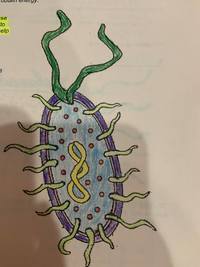
- cell membranes
- Flagella
- DNA
73. What is the primary function of bacterial endospores?
- a) Energy production
- b) Survival in harsh conditions
- c) Protein synthesis
- d) DNA replication
Bacteria of decay are important components of an ecosystem because they
- are involved in photosynthesis
- recycle organic matter
- absorb solar energy
- slow the spread of disease
The gene for antibiotic resistance is found in the ________ inside the bacterial cell. Not all bacterial cells have this structure.
- plasmid
61. What is the term for the process by which bacteria take up DNA from their surroundings and incorporate it into their genome?
- a) Conjugation
- b) Transduction
- c) Transformation
- d) Replication
94. Which bacterial structure is responsible for transferring genetic material from one bacterial cell to another during conjugation?
- a) Ribosome
- b) Conjugation pilus
- c) Flagellum
- d) Capsule
31. Which of the following bacterial diseases can be prevented through vaccination with the BCG vaccine?
- a) Tuberculosis
- b) Tetanus
- c) Cholera
- d) Malaria
What is the yellow

- DNA
- cell wall
- Cytoplasm
Name a BACTERIA that you can get a vaccine for:
- diphtheria
how does bacteria reproduce?
- binary fission
- fussion
- meiosis
- mitosis
The ________ is used by some bacteria to move around in their environment
- flagella
An autotroph is a bacteria which gets its energy from ________
- photosythesis
- photosythesis
- sun
_Select the statements that support the fact that viruses are not alive.
- Viruses are unicellular.
- Viruses are not made of cells.
- Viruses need a host cell to survive.
- Viruses cannot reproduce on their own.
The use of what modern technology has cause the rise in resistant bacteria
- vaccines
- antibiotics
- fertilizers
- solar panels
What type of virus is the Sars-CoV-2 (corona virus)?
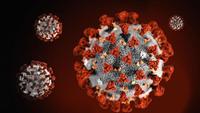
- Retrovirus
- Oncovirus
- Bacteriophage
- Prion virus
39. What is the primary function of bacterial flagella?
- a) Locomotion
- b) Photosynthesis
- c) Protein synthesis
- d) DNA replication
harmful or helpful: bacteria are decomposers
- helpful
- harmful
The kingdom containing disease-causing bacteria and most of the helpful bacteria is
- Eubacteria
- Archaebacteria
how does an active virus reproduce?
- the viral DNA forces a host cell's own machinery to make more viruses
- the viral DNA forces the host cell to go through binary fission
- the viral DNA is replicated and passed on every time the host cell goes through mitosis
- all of the above
72. Which bacterial genus includes species responsible for causing urinary tract infections?
- a) Escherichia
- b) Escherichia coli
- c) Streptococcus
- d) Salmonella
Bacteria are _______, meaning they have _______ _____________________
- Prokaryotes; no nucleus
- Prokaryotes; no DNA
- Eukaryotes; no nucleus
- Eukaryotes; no DNA
Bacteria reproduce asexually by _ and sexually by _.
- binary fission, conjugation
do prokaryotes have a nucleus surrounding their chromosomes of dna?
- no
bacteria has
- no cell wall and no cell membrane
- both cell wall and cell membrane
- cell wall
- cell membrane
cold sores are caused by a(n) _______ virus.
- active
- flu
- host
- latent
70. Which bacterial structure is responsible for transferring genetic material from one bacterial cell to another during conjugation?
- a) Ribosome
- b) Conjugation pilus
- c) Flagellum
- d) Capsule
83. What is the term for bacteria that obtain energy from sunlight?
- a) Phototrophs
- b) Chemotrophs
- c) Heterotrophs
- d) Autotrophs
the slimy coating around a bacterium
- plasmid
- capsule
- capsid
- host cell
What is bacteria?
- single-celled organisms that have no nucleus and can either benefit or harm the body
How long ago did the first life (bacteria) appear on Earth?
- 300 years ago
- 3,000 years ago
- 3 million years ago
- 3.5 billion years ago
A obligate anaerobe is a type of bacteria that
- must have oxygen in its system
- cannot have oxygen in its system
- may or may not need oxygen
- uses sulfur dioxide
Which of the following characteristics promote bacterial growth?
- Suitable temperature 30-50 degrees F
- Moisture
- Darkness
- Space to grow
52. Which bacterial structure is responsible for transferring genetic material from one bacterial cell to another?
- a) Capsule
- b) Conjugation pilus
- c) Flagellum
- d) Ribosome
Which cell part is the thin, flexible covering of a cell that is semi-permeable?
- Cell membrane
- Cell wall
- DNA
- Cytoplasm
What are the symptons of Clostridium Botulium?
- Flaccid muscle paralysis, double vision, general muscle weakness, respiratory paralysis.
- Pockets of gas formation under skin, degrades muscles, limp muscles that secrete black fluid.
- General malaise to menegitis to spontaneous abortions
- Severe dihhera, abdominal cramps, fever
- Severe muscle spasms ( lockjaw)
What does semi-permeable mean?
- Keeps everything out
- Let's certain things in
- Let's everything in
What are types of bacteria?
- Tetanus (Missed)
- Tetanus (Missed)
- Authorax
- Salmonella (Missed)
- Streptococci (Missed)
- Pneumonia (Missed)
- Ecoil
- Staphlorocco (Missed)
24. Which bacterial genus includes species responsible for causing strep throat?
- a) Escherichia
- b) Streptococcus
- c) Staphylococcus
- d) Salmonella
9. Which type of bacteria can survive extreme conditions, such as high temperatures and acidity?
- a) Extremophiles
- b) Gram-negative bacteria
- c) Pathogenic bacteria
- d) Aerobic bacteria
What are the 3 ways bacteria get energy ( food)
- Autotroph consumer mushroom
- Photosynthesis heterotroph autotroph
- Autotroph heterotroph saprotroph
Ribosomes located within bacteria are used to produce
- viruses
- chromosomes
- more bacteria
- proteins
95. What is the term for bacteria that thrive in extremely cold environments?
- a) Psychrophiles
- b) Thermophiles
- c) Acidophiles
- d) Halophiles
85. What is the primary function of bacterial capsules?
- a) Protection from immune cells
- b) Energy production
- c) Nutrient absorption
- d) DNA replication
36. Which of the following bacterial structures is involved in DNA replication?
- a) Flagellum
- b) Capsule
- c) Pilus
- d) Nucleoid
ways you can limit the spread of viral infections
- covering your mouth when coughing
- covering your mouth when coughing
- healthy diet
- be vaccinated
Check all of the non-living characteristics of viruses.
- They are non-cellular.
- They are non-cellular.
- They can mutate or change.
- They have no metabolism.
- They can crystallize.
a protein coat surrounding viral DNA
- capsid
- capsule
- endospores
- microbiota
What do bacterias not have?
- Nucleus
Match the pandemic-causing pathogen to its method of spreading & causing illness: (from EdPuzzle)
- contaminated water; caused death by dehydration Cholera
- sexual contact or from mom to newborn during birth Syphilis
- respiratory or thru infected fabrics Small Pox
- infected fleas biting humans Plague / Black Death
- mosquito bites Yellow Fever
When do bacteria form endospores?
- In the best environment, i.e. enough food, enough
- When the temperature is ambient
- In harsh conditions
- When they are dormant
Harmful bacteria can be found in raw meats, raw eggs, and other foods.
- True
- False
is there a nucleus in a bacterial cell?
- no
What type of bacteria will be killed in the presence of oxygen?
- Obligate aerobes
- Obligate anaerobes
- Facultative anaerobes
- Photoautotrophs
The segment of DNA that is shared between bacteria during conjugation is called the
- bacteriophage
- prophage
- capsid
- plasmid
What are the symptons of Clostridium Difficile?
- Pockets of gas formation under skin, degrades muscles, limp muscles that secrete black fluid.
- Flaccid muscle paralysis, double vision, general muscle weakness, respiratory paralysis.
- Severe muscle spasms ( lockjaw)
- Severe dihhera, abdominal cramps, fever
- General malaise to menegitis to spontaneous abortions
Which microorganisms help your body digest food?
- bacteria
- algae
- fungus
- virus
Which of the following Latin roots correctly describes the shape of these bacteria?

- bacillus
- coccus
- spirillum
- strepto
Which of the following is true for both bacteria and viruses?
- both contain genetic material
- can be killed using antibiotics
- have a cell membrane
- have a protein coat
You can eat WITHOUT microorganisms.
- Yes
- No
- Sometimes
- Probably
thorough hand washing is able to prevent bacterial infections but isn't successful at preventing viral infections.
- true
- false
91. What is the term for bacteria that obtain energy from sunlight?
- a) Phototrophs
- b) Chemotrophs
- c) Heterotrophs
- d) Autotrophs
When bacteria are stressed, what could happen? (select all that apply!)
- Conjugation - exchange of DNA between 2 bacteria
- Conjugation - exchange of DNA between 2 bacteria
- Mutation of DNA that leads to evolution / resistant bacteria
- Bacteria could die
51. What is the term for bacteria that can grow in the presence or absence of oxygen?
- a) Aerobic
- b) Anaerobic
- c) Facultative anaerobic
- d) Obligate anaerobic
7. Which of the following is a beneficial role of bacteria in the human body?
- a) Causing diseases
- b) Digesting food in the gut
- c) Filtering blood
- d) Producing antibodies
Which series lists the correct order of steps of binary fission from first to last?
- DNA is copied ® DNA molecules attach to cell membrane ® cell membrane elongates and pinches off ® two identical cells are produced
Which of the following bacteria use energy from inorganic reactions as a source of energy to build glucose?
- Parasites
- Saprophytes
- Photoautotrophs
- Chemoautotrophs
14. What is the term for the protective structures formed by some bacteria in response to adverse environmental conditions?
- a) Capsules
- b) Pili
- c) Endospores
- d) Cilia
Bacteria that stain red or pink are called
- gram positive
- gram negative
Bacteria reproduce in which way?
- Sexually (binary fission)
- Budding
- Meoisis
- Asexually (binary fission)
Where is bacteria found?
- Everywhere
- Almost everywhere
82. Which of the following bacterial diseases is transmitted through contaminated water and causes severe diarrhea?
- a) Tetanus
- b) Anthrax
- c) Cholera
- d) Plague
What are the 2 types of kingdoms
- Eubacteria and archae
Bacteria can have the following shapes:
- cocci, bacilli, spirilla
- cocci, helical, rods
- complex, helical, polyhedral
- complex, cocci, spirilla, helical
74. Which of the following bacterial diseases is transmitted through contaminated water and causes severe diarrhea?
- a) Tetanus
- b) Anthrax
- c) Cholera
- d) Plague
Which bacterial form can be curved like a spiral, thick and rigid, or thin and flexible?
- spirillum
Describe 2-3 ways each that both viruses and bacteria can be helpful to humans.
- [No Answer]
75. What is the term for bacteria that obtain energy from sunlight?
- a) Phototrophs
- b) Chemotrophs
- c) Heterotrophs
- d) Autotrophs
how are Archaea different from Bacteria?
- they don't have peptidoglycan and bacteria has peptidoglycan
- they don't have peptidoglycan and bacteria has peptidoglycan
- they are similar to eukaryotic cells
- bacteria is similar to prokaryotic cells
Which of these is NOT a way that bacteria can be helpful?
- Aid in digestion of our food
- Protect against harmful bacteria
- Decompose organic matter in soil
- Fix nitrogen in soil for plants to use
- can become resistant to antibiotics
the outside of a bacterial cell is protected by a structure called a
- capsule
How many named species of bacterias are there?
- 40000
- 1500
- 30000
- 8000
transduction
- a method of genetic recombination in bacteria in which dna is transferred between cells by a virus
71. What is the term for bacteria that thrive in extremely cold environments?
- a) Psychrophiles
- b) Thermophiles
- c) Acidophiles
- d) Halophiles
two substances found in viruses
- nucleic acid/DNA or RNA
- nucleic acid/DNA or RNA
- plasmid
- capsid
bacillus
- bacteria with a rod shapeexample: E. coli
What is the cell part labeled as "E"
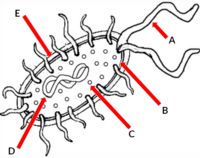
- Cell wall
Bacteria and fungi are __________________________.
- Producers
- Consumers
- Decomposers
- Mushrooms
A bacterium reproduces asexually by dividing to form two new bacterial cells. What is the name of the process by which bacteria reproduce?
- meiosis
- mitosis
- budding
- binary fission
Which bacteria structure is labelled with the star?

- Cell Wall
- Capsule
- Ribosome
- Flagella
What is the name of a virus that has RNA instead of DNA?
- Prophage
- Retrovirus
- Prions
- Viroids
how does bacteria get transmitted?
- Hands (Missed)
- Hands (Missed)
- Insects (Missed)
- Cold weather
- Microwaved food unproperly (Missed)
84. Which bacterial genus includes species responsible for causing botulism?
- a) Streptococcus
- b) Clostridium
- c) Escherichia coli
- d) Salmonella
What does pili do?
- It allows dna to be transferred from one bacterium to another
87. What is the term for bacteria that thrive in extremely cold environments?
- a) Psychrophiles
- b) Thermophiles
- c) Acidophiles
- d) Halophiles
41. What is the term for the protective mechanism that some bacteria use to resist the effects of antibiotics?
- a) Antibiotic resistance
- b) Biofilm formation
- c) Conjugation
- d) Transformation
90. Which of the following bacterial diseases is transmitted through contaminated water and causes severe diarrhea?
- a) Tetanus
- b) Anthrax
- c) Cholera
- d) Plague
How would you get Bacillus Cereus?
- Improperly cooking food, at lower temperatures.
- Infection through infected animal or soil
- By eating smoked fish or improperly canned foods at home
- Innoculated with trama into muslcles
- Penetration of skin by a rusted nail
44. Which of the following bacterial diseases is caused by Mycobacterium tuberculosis?
- a) Tuberculosis
- b) Tetanus
- c) Strep throat
- d) Salmonellosis
plasmid
- a small, circular dna molecule in bacteria
how does bacteria move?more then one answer
- Move by rushing fluid (Missed)
- Move by rushing fluid (Missed)
- Move by flagellum (Missed)
What is the whip-like 'tail' that bacteria use for movement?
- Cell wall
- Ribosome
- Flagella
- Cytoplasm
where is nucleoid?
- it is in the middle and floating
Which viral life cycle kills its host cell by lysing (bursting)?

- Lysogenic Cycle
- Lytic Cycle
- Binary Fission
- Conjugation
harmful or helpful: bacteria "fixes" nitrogen
- helpful
- harmful
Bacteria are....
- Unicellular
- Unicellular
- Multicellular
- Prokaryotic
- Microscopic
What is the most outside part of a bacterium?
- Ribosome
- Cytoplasm
- Cell membrane
- Cell wall
How do viruses move?
- By fluid blood (Missed)
- By fluid blood (Missed)
- By hand contact (Missed)
Which of these conditions would allow extremophile Archaebacteria to survive? (select all that apply)
- high temperatures
- high temperatures
- high salinity
- acidic conditions
- methane-rich
58. Which of the following bacterial diseases can lead to severe lung infection and is caused by Legionella pneumophila?
- a) Tuberculosis
- b) Tetanus
- c) Cholera
- d) Legionnaires' disease
Which is the 3 correct parts of bacteria?
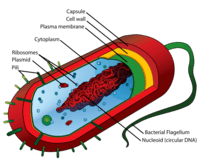
- Cell wall, DNA, Pili
- DNA, Plasmid, Nucleus
- Vacuole, Cell wall, Pili
- Plasmids, Cell membrane, Oytoplasm
Which of the following is true?
- Viruses and bacteria are both prokaryotes.
- Bacteria are eukaryotes and viruses are prokaryotes.
- Some bacteria are prokaryotes and some are eukaryotes.
- All bacteria are prokaryotes.
86. Which bacterial structure is responsible for transferring genetic material from one bacterial cell to another during conjugation?
- a) Ribosome
- b) Conjugation pilus
- c) Flagellum
- d) Capsule
There are five kingdoms of life. Bacteria belong in the kingdom called______
- Monera
There are 5 stages in the growth of bacteria: ___, log, stationary, decline and survival
- lag
The carbohydrate found in the cell walls of Eubacteria is called
- cellulose
- peptidoglycan
- glucose
- chitin
What is a prokaryote?
- a unicellular organism that lacks internal membrane bound structures, including a membrane bound nucleus
Which applies to Enterococcus
- Bile esculin positive (Missed)
- Bile esculin positive (Missed)
- 6.5% NaCl positive (Missed)
79. What is the term for bacteria that thrive in extremely cold environments?
- a) Psychrophiles
- b) Thermophiles
- c) Acidophiles
- d) Halophiles
Test/s that requires 37 degrees Celsius incubation and does not require CO2
- Oxidation/Fermentation (Hugh-Leifson) test
- Bacitracin susceptibility test (Missed)
- Novobiocin susceptibility test (Missed)
- Polymyxin B susceptibility test (Missed)
- Optochin susceptibility test
- Mannitol Salt Agar (Staphylococci identification)
- CAMP Test
- 20% Dextrose Strip Test (Missed)
- Bile solubility test
- Salt Tolerance Test (Missed)
59. What is the term for bacteria that require a low pH (acidic environment) to thrive?
- a) Acidophiles
- b) Alkaliphiles
- c) Halophiles
- d) Mesophiles
viruses aren't made of cells
- true
- false
77. What is the primary function of bacterial capsules?
- a) Protection from immune cells
- b) Energy production
- c) Nutrient absorption
- d) DNA replication
Which form of bacteria is matched correctly to its description?
- coccus—can cause MRSA and has a round shape
99. What is the term for bacteria that obtain energy from sunlight?
- a) Phototrophs
- b) Chemotrophs
- c) Heterotrophs
- d) Autotrophs
5. Which bacterial structure allows for movement?
- a) Flagella
- b) Cilia
- c) Pili
- d) Capsule
A ______________ bacteria gets food from other organisms. They can be saphrophytes or parasitic bacteria.
- heterotrophic
harmful or helpful: bacteria helps ruminants digest cellulose
- helpful
- harmful
Tests performed in BRAIN HEART INFUSION BROTH
- Bacitracin Susceptibility Test
- Novobiocin Susceptibility Test
- Optochin Susceptibility Test
- Polymyxin B Susceptibility Test
- 20% Dextrose Strip Test
- Salt Tolerance Test
10. What is the term for the process by which bacteria exchange genetic material through direct contact?
- a) Binary fission
- b) Conjugation
- c) Transformation
- d) Transduction
Which bacteria cell part goes in the box labelled with the star?

- Flagella
- Chromosomal DNA
- Plasmid DNA
- Cell Wall
What causes clostridium perfringens?
- Colonizes pharaynx
- Innoculated with trauma into muscles (Missed)
- Necroticskin exposed to bacteria, growing and damaging local tissue. (Missed)
Which of the following types of bacteria live on dead organic matter?
- Parasites
- Saprophytes
- Photoautotrophs
- Chemoautotrophs
50. Which bacterial genus includes species responsible for causing botulism?
- a) Streptococcus
- b) Clostridium
- c) Escherichia coli
- d) Salmonella
What is the job of ribosomes in bacteria?
- To provide protection
- To make protiens
- To hold organelles in place
- To hold water and nutrients
Bacteria are found in which of the following places?
- in your digestive system
- in the air
- in soil
- all of the above
Which bacteria cell part goes in the box labelled b?

- Flagella
- Chromosomal DNA
- Ribosomes
- Cell Wall
If bacteria are in a temperature that is too high for them, their enzymes become_________
- denatured
What would happen to a bacterial cell if its protective covering was destroyed?
- It would be harmed by chemicals in the environment.
43. What is the term for bacteria that obtain energy from sunlight?
- a) Phototrophs
- b) Chemotrophs
- c) Heterotrophs
- d) Autotrophs
81. What is the primary function of bacterial endospores?
- a) Energy production
- b) Survival in harsh conditions
- c) Protein synthesis
- d) DNA replication
21. Which type of bacteria stain purple in the Gram staining process?
- a) Gram-positive
- b) Gram-negative
- c) Gram-neutral
- d) Gram-variable
100. Which bacterial genus includes species responsible for causing botulism?
- a) Streptococcus
- b) Clostridium
- c) Escherichia coli
- d) Salmonella
- I hope these questions help with your study of bacteria!
Which of these is characteristic of both viruses and bacteria?
- They get their energy from their environment.
- They can reproduce on their own.
- They can form crystals and become dormant.
- They contain proteins and nucleic acids.
Where can bacteria be found?
- Soil
- Soil
- Rock
- Ocean
- Arctic snow
How do single-cell organisms move? Check all that apply
- flagella
- cilia
- change shape
- all the above
How could you get clostridium tetani?
- By eating smoked fish or improperly canned foods at home
- Infection through infected animal or soil
- Improperly cooking food, at lower temperatures.
- Penetration of skin by a rusted nail
- Innoculated with trama into muslcles
53. What is the primary function of bacterial mesosomes?
- a) Energy production
- b) Protein synthesis
- c) DNA replication
- d) Cell division
what are the surface structures of bacteria?
- capsule, cell wall, and cell membrane
You are looking at a sample under the microscope to see if your patient has a bacterial infection. When you look in the microscope, you see something that looks like this. Is it a bacterium?

- Yes, this is a bacterium
- No, this is not a bacterium
name the shape

- spirillum (spiral shaped)
- bacillus (rod-shaped)
- coccus (sphere-shaped)
45. What is the primary function of bacterial plasmids?
- a) Locomotion
- b) Genetic exchange
- c) Energy production
- d) Protein synthesis
92. Which bacterial genus includes species responsible for causing botulism?
- a) Streptococcus
- b) Clostridium
- c) Escherichia coli
- d) Salmonella
13. Which of the following bacterial structures is responsible for storing genetic material?
- a) Nucleus
- b) Nucleoid
- c) Endoplasmic reticulum
- d) Golgi apparatus
What are the three common shapes of bacteria's
- Spirilli round and rod shaped
- Sprilli bacilli and cocci
- Round spirals and Rod shape
Match the bacteria shapes to the name:
- Bacilli
the helpful microscopic bacterial cells that inhabit your body
- host cell
- microbiota
- endospores
- plasmid
17. Which of the following bacterial infections is typically transmitted through contaminated food or water?
- a) Influenza
- b) Salmonella
- c) Tuberculosis
- d) HIV
Bacteria are classified as prokaryotes because they are missing
- a cell wall
- genetic material
- a nucleus
- ribosomes
Which reason best explains why bacteria can reproduce quickly?
- Binary fission
Bacteria normally replicate through (a) but can use (b) when stressors force them to adapt. Some bacteria form an (c) to go dormant when conditions are poor.
- abinary fission
- abinary fission
- bconjugation
- cendospore
spirillum
- bacteria with an elongated spiral shapeexample: cholera
29. Which bacterial species is commonly used in the fermentation of dairy products like yogurt?
- a) Salmonella
- b) Escherichia coli
- c) Lactobacillus
- d) Clostridium
Match these symptons to the Bacteria A) severe muscle spasms ( lockjaw) B) Severe dihhera, abdominal cramps, feverC) general malaise to menegitis to spontaneous abortionsD) pockets of gas formation under skin, degrades muscles, limp muscles that secrete black fluid. E) Flaccid muscle paralysis, double vision, general muscle weakness, respiratory paralysis.F) Colonizes Pharaynx, forms grayish pseudomembrane composed of fibrin, leukocytes, exotoxins damage heart and neural cells
- A) Clostridium tetani
- B) Clostridium Difficile
- C) Listeria
- D) Clostridium Perfringens
- E) Clostridum Botulism
- F)Corynebaterium Dipheria
a cell infected by a virus
- capsid
- plasmid
- capsule
- host cell
26. What is the primary role of bacteria in the nitrogen cycle?
- a) Carbon fixation
- b) Oxygen production
- c) Nitrogen fixation
- d) Phosphorus cycling
65. What is the term for the process by which bacteria convert atmospheric nitrogen into a form that plants can use?
- a) Photosynthesis
- b) Nitrogen fixation
- c) Fermentation
- d) Respiration
Which microorganisms are harmful? CHECK ALL THAT APPLY!
- salmonella
- salmonella
- e coli
What part of bacteria sell helps it stick to surfaces
- Flagella
- RNA
- pilus
55. What is the term for bacteria that live in the absence of oxygen and are often found in the digestive tract?
- a) Aerobic
- b) Anaerobic
- c) Facultative anaerobic
- d) Microaerophilic
We can produce products such as antibiotics or dairy products in a container known as a
- petri dish
- bioreactor
- test tube
- water bath
What do saprotrophs do (decomposers)
- Break down
- A process that uses bacteria to convert nitrogen into useful proteins
- Cleans up oil spills
What process occurs when bacteria break down nitrogen gas into a form that plants can use?
- binary fission
- conjugation
- nitrogen fixation
- decomposition
small, circular strands of DNA
- plasmids
What do all viruses have?
- Protein Coat (capsid)
- Protein Coat (capsid)
- DNA or RNA (Missed)
11. Which of the following is a disease caused by bacteria?
- a) Tuberculosis
- b) Malaria
- c) AIDS
- d) Influenza
67. What is the term for bacteria that require high salt concentrations to grow?
- a) Halophiles
- b) Acidophiles
- c) Thermophiles
- d) Mesophiles
Endotoxins : 1) plasmid called pXO1 which has three different proteins a) edema factor (EF) b) ? c) ? and whats the second endotoxin? Finally, which bacillus is this?
- B) neurotoxin,c) lethal factor , Plasmid pX02, Bacillus anthracis
- b) Protective antigen(PA) c) Lethal Factor ( LF) and plasmid pX02 ; Bacillus anthracis
- B)tetanospasmin c) Protective antigen ; plasmid pXO2 ; Bacillus anthracis
- B) Protective antigen(PA) c) Lethal Factor ( LF) and plasmid pX02 ; Bacillus cereus
20. What is the primary function of bacterial endospores?
- a) Reproduction
- b) Survival in harsh conditions
- c) Protein synthesis
- d) Energy production
Which microorganism can cause diseases and infections in people?
- Bacteria
- All of the above
- Fungus
- Virus
32. Which bacterial genus includes species responsible for causing food poisoning?
- a) Escherichia
- b) Streptococcus
- c) Salmonella
- d) Clostridium
Where are viruses found?
- Almost everywhere
- Everywhere
Some bacteria are autotrophs. This means they
- eat each other
- make their own food
- become parasites
- use chemicals to break down their food source
Which applies to Group B strep
- Hippurate positive (Missed)
- Hippurate positive (Missed)
- CAMP positive (Missed)
what are the appendages?
- pill and flagellum
An heterotroph is a bacteria which gets its energy from
- autotrophs
- autotrophs
- eating
BONUS QUESTION (+2 points):Which microorganism is one of the oldest things on Earth?
- algae
Can a virus change the normal activity of a cell?
- No
- Maybe
- Yes
25. Which of the following bacterial diseases can be transmitted through the bite of an infected tick?
- a) Cholera
- b) Lyme disease
- c) Tuberculosis
- d) Malaria
Bacterial is eukaryotic organisms
- true
- false
Which ones are BETA HEMOLYTIC
- S. pyogenes (Missed)
- S. pyogenes (Missed)
- S. agalactiae (Missed)
- S. dysgalactiae (Missed)
- S. equi (Missed)
- S. equisimilis (Missed)
- S. zooepidermicus (Missed)
- S. bovis
- S. equinus
- E. faecalis (Missed)
- E. avium (Missed)
- E. durans (Missed)
- E. faecium (Missed)
- S. pneumoniae
- S. anginosus (Missed)
- S. mutans (Missed)
- S. mitis (Missed)
- S. salivarius (Missed)
- S. sanguis (Missed)
Which part of the bacteria is always present?
- Cell wall
- Plasmid
- Flagella
- Capsule
Which type of microorganism is the LARGEST?
- Bacteria
- Algae
- Fungus
- Virus
69. What is the primary function of bacterial capsules?
- a) Protection from immune cells
- b) Energy production
- c) Nutrient absorption
- d) DNA replication
What are examples of Viruses?
- Ecoil
- Tetanus
- Common Cold (Missed)
- Flu (Missed)
- HIV (Missed)
- Herpes (Missed)
- Chicken Pox (Missed)
Which of the following creates genetic variation among bacteria?
- binary fission
- conjugation
Which mode of reproduction is matched correctly with its description?
- transduction—virus transfers genes from one bacteria to another
What does bacteria do?
- Break down carbohydrates
- Break down carbohydrates
- Help protect the cells in your intestines from invading pathogens
- Help us absorb fatty acids
- Promote repair of damaged tissue
Why is the cytoplasm in cells important?
- It controls the activities of the cell
- It provides support and shape for the cell
- It controls what enters and exits the cell
- It keeps other cell parts from colliding and damaging each other
18. What is the term for bacteria that require oxygen to grow?
- a) Aerobic
- b) Anaerobic
- c) Facultative anaerobic
- d) Obligate anaerobic
how can you prevent viral infections?
- by washing your hands regularly
- by eating a balanced diet
- by being vaccinated
- all of the above
a latent virus can remain in the body for years before destroying the host cells
- true
- false
33. What is the term for the process by which bacteria break down
- a) Photosynthesis
- b) Decomposition
- c) Nitrogen fixation
- d) Fermentation
46. Which bacterial genus includes species responsible for causing urinary tract infections?
- a) Escherichia
- b) Escherichia coli
- c) Streptococcus
- d) Salmonella
Which of the following are identified as archaeal groups?
- Methanogens
- Methanogens
- Eubacteria
- Halophiles
- Thermoacidophiles
do bacteria have a nuclei?
- no
- yes
The hair like structure in bacteria cell are called
- Nucleus
- Flagella
- Mitochondria
- Cell wall
78. Which bacterial structure is responsible for transferring genetic material from one bacterial cell to another during conjugation?
- a) Ribosome
- b) Conjugation pilus
- c) Flagellum
- d) Capsule
We eat fungi?
- True
- False
Consider this microscopic image of bacteria. mc005-1.jpgWhich bacterial shape is shown in the image?
- spiral
Which microorganism is the SMALLEST?
- bacteria
- algae
- fungus
- virus
Type of virus that can be spread from insects:

- oncovirus
- arbovirus
- retrovirus
- all of these
Name a virus that you can be vaccinated for (BESIDES COVID)
- flu
what does the cell wall do?
- it provides a rigid structure that gives the cell its shape
Which applies to Micrococcus spp.
- Fermentative
- Oxidative (Missed)
- Oxidase negative
- Oxidase positive (Missed)
- Bacitracin resistant
- Bacitracin susceptible (Missed)
Consider this microscopic image of bacteria.mc003-1.jpgBased on its shape, what is most likely the form of this bacteria?
- bacillus
Organisms WITHOUT a nucleus?
- Bacteria
- Fungus
- Amoebas
- Virus
Viruses must bind to specific proteins on the cell surface because of this, animal viruses can only infect _______ cells.
- animal
There are two types of food processing we have to learn: _____ and continuous flow culture
- batch
Harmful mold and other fungi can...Check ALL that apply.
- Rot wood
- Rot wood
- cause diseases
49. What is the primary function of bacterial inclusions?
- a) Storage of nutrients and metabolic byproducts
- b) Protein synthesis
- c) Energy production
- d) DNA replication
How does a virus get energy?
- It produces energy
- From host cell
- They dont need it
There are approximately 10 times as many human cells as bacteria cells in the human body.
- True
- False
38. Which of the following bacterial diseases is caused by a spirochete bacterium?
- a) Tuberculosis
- b) Strep throat
- c) Salmonellosis
- d) Syphilis
16. What is the primary mode of nutrition for autotrophic bacteria?
- a) Heterotrophy
- b) Photosynthesis
- c) Predation
- d) Parasitism
Bacteria can be found in
- The land only
- aquatic areas only
- temperate places on land
- every place ever
Ribosomes are also found in bacteria cell.
- True
- False
Tests performed in MUELLER-HINTON AGAR
- Bacitracin Susceptibility Test
- Novobiocin Susceptibility Test (Missed)
- Optochin Susceptibility Test
- Polymyxin B Susceptibility Test (Missed)
What is the cell part labeled as "B"
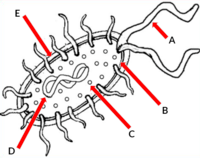
- Cell membrane
Which applies to Staphyloccocus spp.
- Fermentative (Missed)
- Fermentative (Missed)
- Oxidative
- Oxidase negative (Missed)
- Oxidase positive
- Bacitracin resistant (Missed)
Which kingdom of bacteria is more closely related to eukaryotes?
- Archaebacteria
- Eubacteria
34. Which of the following bacterial infections can lead to the formation of pus-filled abscesses?
- a) Tuberculosis
- b) Lyme disease
- c) Cholera
- d) Staphylococcal infection
What do doctors use to prime our immune systems to resist viruses?
- antibiotics
- vaccines
- gene therapy
- chemotherapy
Name and describe the two enterotoxins of bacillus anthracis and the3 different proteins associated with one of them.
- 1) Plasmid called PXO1 with three proteins a) edema factor ( EF) that disrupts water homeostasis b) protective antigen ( PA) that promotes the entry of EF into the phagocytic cell c) Lethal factor ( LF) zinc metalloprotease that inactivates protein kinease. 2) Plasmid PX02 that encodes 3 genes required for synthesis of poly-glutamyl capsule.
Bacteriophage is a virus that can infect bacteria.
- True
- False
88. Which bacterial genus includes species responsible for causing urinary tract infections?
- a) Escherichia
- b) Escherichia coli
- c) Streptococcus
- d) Salmonella
Identify the energy sources used by autotrophic bacteria
- decaying matter
- sunlight
- inorganic chemicals
These organisms only have one cell.
- single-cell organisms
- multi-cell organisms
- plants
- humans
Which statement is true about viruses?
- Viruses can eat and metabolize food.
- Viruses can reproduce only using a host cell.
- Viruses can reproduce on their own at any time.
- Viruses contain DNA, so they are alive.
What type of virus uses RNA that is translated in hosts to create new viruses?
- oncoviruses
- retroviruses
- prophages
- viroids
One important way to control the spread of viruses in through
- the use of vaccines
- drinking a lot of tea
- the use of other types of bacteria
- the use of antibiotics
Microorganisms are so small they can only be seen ________________.
- From the sky
- In a science lab
- through a microscope
- in the dirt
What do prokaryotes have on the outside of their cell membrane that gives protection and support?
- the cell wall
what does the cell membrane do
- helps to transport ions, nutrients, and waste.
3. What is the function of the bacterial cell wall?
- a) DNA replication
- b) Protein synthesis
- c) Providing structural support
- d) Energy production
Which of the following is a viral infection?
- cholera
- influenza
- strep throat
- tuberculosis
How does a virus reproduce?
- With a female virus
- By controlling a cell to make copies
- They cant reproduce
_Select each of the following structures that are found in a virus.
- genetic material
- genetic material
- nucleus
- cell membrane
- capsid (protein coat)
12. What is the primary function of ribosomes in bacterial cells?
- a) Energy production
- b) Protein synthesis
- c) DNA replication
- d) Waste elimination
name the shape

- spirillum (spiral shaped)
- bacillus (rod-shaped)
- coccus (sphere-shaped)
What is the job of the cell wall in bacteria?
- To provide protection
- To make protiens
- To hold organelles in place
- To hold water and nutrients
harmful or helpful: bacteria can give you strep throat
- helpful
- harmful
To keep up this site, we need your assistance. A little gift will help us alot.
Donate- The more you give the more you receive.
Related SubjectWalking Pneumonia: Causes and Trends
Cell Theory
Gender and Society
Prehistoric Sloths in Brazil
Tadpoles: From Water to Land
Life Science
Biology
Anthropology
Vibrant Triangle Indian Community
Kamala Harris: Insights into the Vice President’s Life and Work
Learning Communities
Understanding Culture Society and Politics
The Teacher and the Community School Culture and Organizational Leadership
Special Topics in Human Resource Management
Teaching Social Studies in Elementary Grades: Culture and Geography
Multi Cultural Diversity in Workplace for the Tour
Introduction to Criminology
Social and Professional Issues
Big Lots Business Insights
Introduction to inflation
Retail Sales Surge in October
Investment Strategies: Palantir Generational Stock
United States Markets Surge
Entrepreneurship Information
Barber Shop Business Plans
Small Business Management
Venture Capital
Strategic Business Analysis
Strategy Management and Acquisition
Adipose Tissue
Calculus-Based Physics 2
Show All Subject
Affiliate Links
Shopee Cashback Voucher
Temu $0 Shipping Fee
Amazon 75% Off Discounts